Here is a wonderful story from our great friend and author, Stuart Miller-Osborne. It is about a place in Kent strongly associated with Noel Coward, Ian Fleming and major film stars. It is fascinating and I loved it. Hope you do too.
Out and About
Here is a question. What links the last place in England to be bombed during World War One and one of the biggest Hollywood stars of her generation? It links Brief Encounter with the creator of James Bond. And what connection do these have with the antiques trade?
 The answer is St Margaret’s Bay in Kent which I had the pleasure to visit with my lovely wife a few days ago during our holiday in Kent. St Margaret’s Bay, where is that you may ask? The answer is just a stone’s throw from the town of Dover. Basically it is just a small bay around about three miles from the famous town. Yet it could not be more different. Whilst Dover (which I have always liked) is currently a rather sad and shabby coastal town, St Margaret’s Bay and the village above the bay St Margaret’s at Cliffe are typically Kent tranquil. This is the Kent of our childhood. There is one shop and a number of pubs. The buses do not run on time. And you need to be pretty fit to survive the climb between the beach and the village above (it is indeed a three part village if you take into account the area of Nelson Park a little further inland).
The answer is St Margaret’s Bay in Kent which I had the pleasure to visit with my lovely wife a few days ago during our holiday in Kent. St Margaret’s Bay, where is that you may ask? The answer is just a stone’s throw from the town of Dover. Basically it is just a small bay around about three miles from the famous town. Yet it could not be more different. Whilst Dover (which I have always liked) is currently a rather sad and shabby coastal town, St Margaret’s Bay and the village above the bay St Margaret’s at Cliffe are typically Kent tranquil. This is the Kent of our childhood. There is one shop and a number of pubs. The buses do not run on time. And you need to be pretty fit to survive the climb between the beach and the village above (it is indeed a three part village if you take into account the area of Nelson Park a little further inland).
 But enough of this geography. Why does this now obscure bay still have a claim to fame? Well it is not that it was the last place on the mainland to be bombed during World War One. It was because of a certain Noel Coward who lived in St Margaret’s Bay between 1945 and 1951. He actually owned another house Goldenhurst which had been requisitioned by the army and in 1945. He purchased White Cliffs which was in pretty bad shape at the time as it had been torn apart by British and Canadian troops in preparation for D Day.
But enough of this geography. Why does this now obscure bay still have a claim to fame? Well it is not that it was the last place on the mainland to be bombed during World War One. It was because of a certain Noel Coward who lived in St Margaret’s Bay between 1945 and 1951. He actually owned another house Goldenhurst which had been requisitioned by the army and in 1945. He purchased White Cliffs which was in pretty bad shape at the time as it had been torn apart by British and Canadian troops in preparation for D Day.
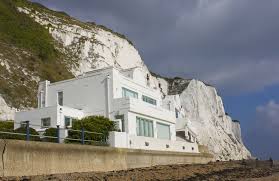 He said at the time, that he felt he would be happy there with the waves lapping the walls of his bedroom (in bad weather I would imagine) and the vast white cliffs rising steeply behind the house. There were also some modernist houses right next to Coward’s house and he attempted to purchase these also, so that his privacy could be assured. He actually ran into problems at the time because of this, as there were restrictions in place because of the housing shortage in the South East following the war. This hurdle was cleared when his friends purchased the houses instead. This was investigated by the Ministry of Works but no laws were found to have been broken.
He said at the time, that he felt he would be happy there with the waves lapping the walls of his bedroom (in bad weather I would imagine) and the vast white cliffs rising steeply behind the house. There were also some modernist houses right next to Coward’s house and he attempted to purchase these also, so that his privacy could be assured. He actually ran into problems at the time because of this, as there were restrictions in place because of the housing shortage in the South East following the war. This hurdle was cleared when his friends purchased the houses instead. This was investigated by the Ministry of Works but no laws were found to have been broken.
 After the house had been repaired, the guests began to arrive and soon the small bay began to be known by the name Piccadilly on Sea (as it had been named many years previously). Celebrities such as Gertrude Lawrence and Daphne Du Maurier were frequently seen as was the actor Joseph Cotton. But, it was the arrival of the Hollywood stars Spencer Tracy and Katherine Hepburn which attracted the attention as they would often drive down from London see Coward and his friends. Kate was also famed for her morning dips in the sea (often in freezing weather) which she undertook on a regular basis. I
After the house had been repaired, the guests began to arrive and soon the small bay began to be known by the name Piccadilly on Sea (as it had been named many years previously). Celebrities such as Gertrude Lawrence and Daphne Du Maurier were frequently seen as was the actor Joseph Cotton. But, it was the arrival of the Hollywood stars Spencer Tracy and Katherine Hepburn which attracted the attention as they would often drive down from London see Coward and his friends. Kate was also famed for her morning dips in the sea (often in freezing weather) which she undertook on a regular basis. I  actually paddled in the sea there (with great difficulty as it is very rocky and the pebbles were not all that kind to your feet) and can assure you, that even in July, the waters were
actually paddled in the sea there (with great difficulty as it is very rocky and the pebbles were not all that kind to your feet) and can assure you, that even in July, the waters were
not all that warm. My ambitions to repeat Kate’s swimming exploits were soon abandoned. Another visitor to White Cliffs was Coward’s great friend the writer, Ian Fleming, who we all know created James Bond. Indeed, his novel Moonraker is set in the Dover/Deal area.
I can see how Coward was happy there; it was incredibly convenient for London and Paris but was again in the middle of nowhere. He often caught The Golden Arrow ferry (do you remember that?) and within hours was in Calais picking up food that was not available in England because of rationing. He would sometimes go to Paris where he often met friends such as Maurice Chevalier, Marlene Dietrich and Mary Pickford amongst others.
During his trips to Jamaica (where he is now buried) he often loaned his house to the Duke of Kent and his family which caused even more excitement in the area. Sadly, this was not to last as the public then were as just as they are today, they like to see celebrities. What Coward wanted more than anything was a retreat. a place to relax and work and think. The continuing stream of people to St Margaret’s Bay really gave him no choice, his privacy had been invaded.
 During his time at White Cliffs, he worked on Blithe Spirit and he rewrote This Happy Breed and Brief Encounter so that they could be filmed (although I think This Happy Breed does predate his stay). In 1951 he sold White Cliffs to Ian Fleming who lived there until 1957. I think his wife was not too impressed with White Cliffs due to the crumbling chalk cliffs above and the amount of seaweed that was to be found around the house.
During his time at White Cliffs, he worked on Blithe Spirit and he rewrote This Happy Breed and Brief Encounter so that they could be filmed (although I think This Happy Breed does predate his stay). In 1951 he sold White Cliffs to Ian Fleming who lived there until 1957. I think his wife was not too impressed with White Cliffs due to the crumbling chalk cliffs above and the amount of seaweed that was to be found around the house.
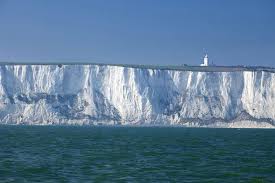 His other memorable creation Chitty Chitty Bang Bang, was also partially set in Kent, when the famous car flew to the nearby Goodwin Sands where the Potts family enjoyed a picnic in the middle of the channel. Today, in my view, St Margaret’s Bay is full of ghosts (especially if you are aware of the history of the area). As you walk towards the beach on the lane above the only inn, there are the remnants of a wall built during Napoleonic times to help defend the area. This is a reminder of how close St Margaret’s Bay is to France (which is visible on most days). I am told that this is the nearest point on the English mainland to our continental neighbour (just over twenty miles) and obviously would have been an early calling point should an invasion have occurred. Although the major guns
His other memorable creation Chitty Chitty Bang Bang, was also partially set in Kent, when the famous car flew to the nearby Goodwin Sands where the Potts family enjoyed a picnic in the middle of the channel. Today, in my view, St Margaret’s Bay is full of ghosts (especially if you are aware of the history of the area). As you walk towards the beach on the lane above the only inn, there are the remnants of a wall built during Napoleonic times to help defend the area. This is a reminder of how close St Margaret’s Bay is to France (which is visible on most days). I am told that this is the nearest point on the English mainland to our continental neighbour (just over twenty miles) and obviously would have been an early calling point should an invasion have occurred. Although the major guns 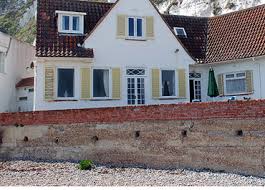 located in the area have been removed, one can still clearly see the wartime defences in situ (there is an accessible pill box located at the Dover end of the bay). This is haunting enough, but what I found most haunting was the presence of the modernist houses at the far end of the bay which initially hide White Cliffs. In a way it is odd to see them there right on the beach and when one gets closer, one sees that they are empty, although furnished (they are holiday lets).
located in the area have been removed, one can still clearly see the wartime defences in situ (there is an accessible pill box located at the Dover end of the bay). This is haunting enough, but what I found most haunting was the presence of the modernist houses at the far end of the bay which initially hide White Cliffs. In a way it is odd to see them there right on the beach and when one gets closer, one sees that they are empty, although furnished (they are holiday lets).
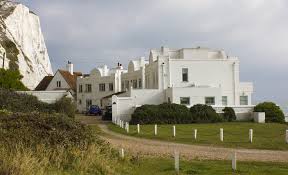 White Cliffs, when I visited it was empty and obviously had been a little changed by owners since 1957. I looked over the wall onto the terrace (now totally empty) and thought of all the parties and gatherings that must have taken place there. I looked at the beach, where Kate used to reach the sea in all weathers. Everything was quiet and apart from a couple of German visitors, I was alone.
White Cliffs, when I visited it was empty and obviously had been a little changed by owners since 1957. I looked over the wall onto the terrace (now totally empty) and thought of all the parties and gatherings that must have taken place there. I looked at the beach, where Kate used to reach the sea in all weathers. Everything was quiet and apart from a couple of German visitors, I was alone.
There was an eerie silence to the area and this was further enhanced by the incredible light that one finds in this part of Kent. It is a very defined light which can be found in St Ives and in Venice as well as the South of France and elsewhere as you travel south. Turner loved it and during his time in nearby Margate, he often commented on the light.
On the day Caron and I visited St Margaret’s Bay there were less than five dozen people to be seen and on chatting to a local, I was assured that the bay did not get that busy, even at the height of summer. It was well known but was a little forgotten. There is one Inn there and a small unit selling tea and other goodies and that is it.
How do you get there you may ask? Well it is really quite simple. If you are driving then find the Dover to Deal road and St Margaret’s is well signposted and about two miles distant.
By train you go to Martin’s Mill (between Dover and Walmer) and follow Station Road towards the main Dover Road. If you survive crossing this road then just follow your nose into St Margaret’s on Cliffe which is directly above the bay. I would not advise the walk from the station as this can be a little hair raising due to the traffic and the winding nature of the road. There is an adequate bus service from Dover and Deal, (which appears to run to its own timetable) which drops you in the village and is most convenient.
The steps that lead to St Margaret’s Bay (if you are walking from the village) are a little steep and were for some reason quite damp (even in July) but generally are good.
Or you can just drive down the hill (there appears to be ample parking at the bay).
How, may you ask, does this fit in with the antiques trade and Hungerford? Well, I think I can sum it up in one word collectables. Noel Coward is very well known and there is a mountain of collectables available if you search them out. He was a composer, a playwright, director, actor and singer amongst other things and I often see scores and other ephemera of his for sale. Only today whilst writing this article, I popped down to the Arcade to purchase his 1937 autobiography, Present Indicative, as I needed to confirm a couple of points I was researching. The book (which was a first edition) was cheaper than the Sunday paper I had previously purchased and will be read (time permitting) in the coming weeks. If I wanted a copy of let’s say Private Lives or The Vortex or even Hay Fever I do not suppose that I would have to wait long before finding one. I would imagine that signed photographs are quite easily found (although I have not seen one for several years). His music scores and film scripts must show up from time to time. If you are a serious collector with a defined budget then you will seek out his work possibly at auction. But most of us who admire his work will just wait and see what comes along which, in my view, is more fun.
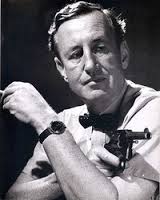 His great friend Ian Fleming, who I have already noted purchased White Cliffs from Coward in 1951, is, in my view, an underrated author. His success with the Bond novels overshadowed everything else that this very talented man produced. I remember that one of the first books I was given was a paperback copy of Goldfinger which I read (after a fashion) aged nine. For some reason this book opened up my imagination and soon I was writing rather childlike short stories about the secret agents of C.H.A.N.N.E.L and their fight against evil. My hero was called Victor Shoreway instead of James Bond and I was
His great friend Ian Fleming, who I have already noted purchased White Cliffs from Coward in 1951, is, in my view, an underrated author. His success with the Bond novels overshadowed everything else that this very talented man produced. I remember that one of the first books I was given was a paperback copy of Goldfinger which I read (after a fashion) aged nine. For some reason this book opened up my imagination and soon I was writing rather childlike short stories about the secret agents of C.H.A.N.N.E.L and their fight against evil. My hero was called Victor Shoreway instead of James Bond and I was
always grateful to Fleming for helping me along. Recently I found a sad but rather amusing story about Fleming who died at the age of 53 on the 12th of August 1964. On the previous day, he had been playing golf at the Royal St Georges Golf Club in Sandwich but he collapsed with a heart attack shortly after a meal. As he was taken to hospital in Canterbury (and these are likely to have been his last recorded words) he apologised to the ambulance crew for having inconvenienced them saying, “I am sorry to trouble you chaps, I don’t know how you get along so fast on the roads these days”.
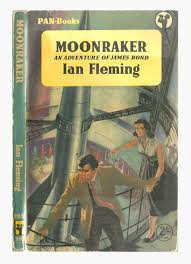 Having walked along many a road and lane in this area of Kent I can assure you that the situation has not improved in the last fifty years. One can buy copies of the James Bond novels quite cheaply in paperback form and outside of first editions, hardback copies are quite reasonable to buy. If you are after a first edition of one of his Bond novels then you can, at times, expect to part with quite serious money. I have, I believe, read the whole series of his Bond novels and occasionally re-read one when on hols. I was going to take a copy of Moonraker down with me this year but, as normal, l could not locate it in my study.
Having walked along many a road and lane in this area of Kent I can assure you that the situation has not improved in the last fifty years. One can buy copies of the James Bond novels quite cheaply in paperback form and outside of first editions, hardback copies are quite reasonable to buy. If you are after a first edition of one of his Bond novels then you can, at times, expect to part with quite serious money. I have, I believe, read the whole series of his Bond novels and occasionally re-read one when on hols. I was going to take a copy of Moonraker down with me this year but, as normal, l could not locate it in my study.
But St Margaret’s Bay is not just about Noel Coward and Ian Fleming, as it has other connections to fame. Channel swimmers nearly always start from there and a number of submarine telephone cables also start from the bay and I believe that Marconi used this area to test his communications long before Noel Coward arrived. One can see tall masts on the cliffs as the village is approached. although these cannot be seen from the bay. In a way there is something for everyone. If you want peace and quiet then it is there in bucket loads. If you want ghosts then just close your eyes. If you are interested the bay’s history then there is more.
It was also very popular prior to Coward and Fleming moving there. Indeed, Henry Royce (of Rolls Royce fame) lived there high on the cliffs and other well to do and well known people either purchased summer homes or lived there all the year round. More recently, the late Peter Ustinov lived there and the actress Miriam Margolyes now lives in his old house. I do not celebrity spot and as I have intimated, you would be hard pressed to see anybody famous at St Margaret’s Bay today. But if you look closely, then you will feel their presence whether it be the house parties and gatherings at White Cliffs or the famous Hollywood couple arriving from London.
.
You will think of Fleming’s Bond novels and the many brave soldiers stationed here over the last two hundred years. But if I was you. I would just sit on one of the many benches and look out to sea and enjoy the magnificent light on the English Channel which, even on dull days, is memorable.
If you feel like reading then why not buy one of the many Arthur Mee guidebooks to Kent (there were a number at the Arcade when I last looked) and learn more about this fascinating county of which St Margaret’s Bay is only but a small part.
Do enjoy your visit.
Stuart Miller-Osborne
